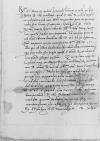Mitto iis inditum exemplum ⌊⌋ mearum, ex quo Reverendissima Dominatio Vestra intelliget, quid serenissimae ⌊maiestati regiae⌋ ob id maxime, ut vel saltem sub eius maiestatis temporibus pace in ⌊iis terris⌋ nobis frui liceat, scripserim. Cumque sciam Dominationem Vestram Reverendissimam suapte sponte rebus hic illustrissimi domini ⌊ducis⌋ singulari quodam studio esse propensam, non ambigo, quin et ad meam commendationem illi Dominatio Vestra non sit defutura. Quam impense oro, ut nuntiis ⌊eius dominationis illustrissimae⌋ et illis, qui ab omnibus ordinibus ⌊ditionum illius⌋ mittuntur, opera sua velit esse praesto apud serenissimam ⌊maiestatem regiam⌋, ut id, quod iure petunt, assequi possint.
Quam inciviliter negotium limitum nuper ex ⌊Magno Ducatu⌋ tractatum sit, existimo iam Dominationem Vestram Reverendissimam ab illustrissimi domini ⌊ducis⌋ ⌊cancellario⌋ accepisse. Nobis hoc tempore, quo infidelium vires, peccatis nostris exigentibus, adeo invaluerunt, nihil pace et ad illam conciliandos animos sollicitudine deberet esse desiderabilius, ne gravius in nos Dei iram concitemus. Ut igitur ad ea, quae ad communem tranquillitatem conservandam pertinent, Dominatio Vestra Reverendissima, quantum licet et potest, intendat, quantum studiosius possum oro.
Illique commendatissimus esse cupio atque omnia faustissima precor.
 GStA PK, HBA, C 1, No. 807, f. 2r
GStA PK, HBA, C 1, No. 807, f. 2r
